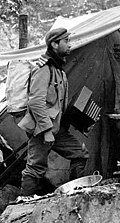File:Iron Chink Bellingham 1905.png

Size of this preview: 768 × 600 pixels. Other resolutions: 308 × 240 pixels | 615 × 480 pixels | 984 × 768 pixels | 1,280 × 999 pixels | 2,560 × 1,999 pixels | 5,292 × 4,132 pixels.
Original file (5,292 × 4,132 pixels, file size: 14.3 MB, MIME type: image/png)
File history
Click on a date/time to view the file as it appeared at that time.
| Date/Time | Thumbnail | Dimensions | User | Comment | |
|---|---|---|---|---|---|
| current | 02:39, 11 January 2021 |  | 5,292 × 4,132 (14.3 MB) | Jmabel | == {{int:filedesc}} == {{Information |Description={{en|Men operating an "Iron Chink" at the processing plant of Pacific American Fisheries, South Bellingham, WA, 1905. E. A. Smith's "Iron Chink", a cleaning device marketed to replace Chinese fish canners using anti-immigration and racist rhetoric. A Chinese laborer stands beside the machine. Additional information included inside the large print enclosure: newspaper clipping with the caption "A Chinese cannery worker at the P.A.F. Cannery in... |
File usage
No pages on the English Wikipedia use this file (pages on other projects are not listed).





